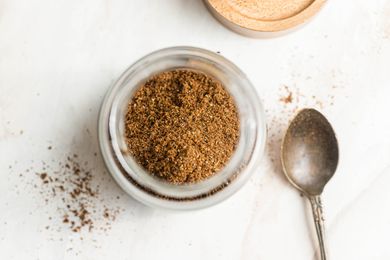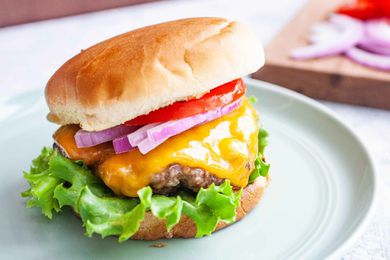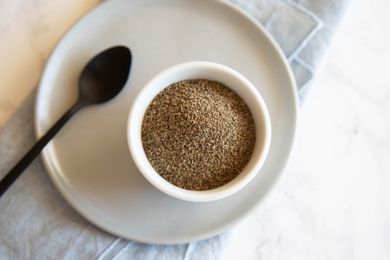:max_bytes(150000):strip_icc()/Simply-Recipes-Homemade-Old-Bay-Seasoning-LEAD-618-08f438e2967245d2a9ce3a940f1ee75e.jpg)
Simply Recipes / Photo by Jen Causey / Food Styling by Margaret Dickey / Prop Styling by Lydia Pursell
Considering it’s a spice mix, Old Bay is a cultural phenomenon–particularly if you live in or around Maryland, its birthplace. Unlike seasoning blends such as steak seasoning or poultry seasoning, Old Bay is a brand name with a highly traceable origin story. You can buy Old Bay merch, snack on Old Bay-flavored Goldfish crackers, and drench your dinner plate in Old Bay Hot Sauce.
Old Bay seasoning has a remarkable history; it’s relatively new in the world of go-to spice blends (considering that some, like za’atar, are centuries old). To appreciate Old Bay on a deeper level, it pays to know its remarkable past.
The Origins of Old Bay Seasoning
Old Bay is a Maryland creation through and through. Baltimore, specifically. But its inventor was a German Jew who fled Nazi Germany with his family in 1938. Gustav Brunn made a new life in Baltimore, where he continued building on his career experience selling wholesale spices. Brunn sold spice mixes to sausage makers, many of whom were likewise German immigrants. He then had a reputed short stint at McCormick, where he claimed he was fired for his shaky English.
Going into business on his own across from the Baltimore Wholesale Fish Market changed his fortunes. The fact that lots of his grocer and meat packer clients spoke Yiddish or German didn’t hurt. According to NPR affiliate WAMU, Brunn received requests from fishmongers for spices for the crabs they steamed. He created a ready-to-use blend with some unlikely ingredients, including warming spices such as cinnamon, nutmeg, and clove–all ingredients that make cameos in German different regional sausage seasonings–to make his blend distinctive and difficult to duplicate. It caught on and grew into a household pantry staple beyond the Mid-Atlantic.
Grunn’s Baltimore Spice Company remained family-run until 1985. McCormick went on to buy the Old Bay recipe and rights and continues to make it to this day.
:max_bytes(150000):strip_icc()/Simply-Recipes-Homemade-Old-Bay-Seasoning-LEAD-616-f1012f29672241ac93967de2c51c5298.jpg)
Simply Recipes / Photo by Jen Causey / Food Styling by Margaret Dickey / Prop Styling by Lydia Pursell
Why Make Homemade Old Bay?
Given that the yellow, red, and blue tin is such a familiar sight, why would you make your own? For one thing, it’s fun. It really lets you experience Old Bay from the inside, so to speak. Another reason is freshness. Just like when you blend your own curry powder, the flavor-forward combination of fragrant spices from your own rack transforms the old bay experience (note the lowercase letters) from two dimensions into three. Plus you are in control of the ingredients. Want it spicier? Add more cayenne. On a low-sodium diet? Decrease the salt.
Our Copycat Old Bay
“Flavor-wise, I'd say this is very very similar to store-bought Old Bay,” says recipe developer Nicole Hopper of the Simply Recipes test kitchen. “You get the initial intensity of the celery salt, backed up by the bay, ginger, and paprika and rounded out by the warmth of the nutmeg, allspice, and cinnamon.”
Nicole included ground bay leaf, which is not a common spice rack ingredient but is a signature element of Old Bay. “The ground bay is optional but does add good flavor―it’s also a good way to use up the broken up bits and torn leaves at the bottom of your bay leaf jar.”
Simple Tip!
To make a salt-free seasoning, omit the celery salt and use 3 1/2 teaspoons of ground celery seed. Then, when you cook with your blend, you can add salt to taste. This is a good route for then you want tons of Old Bay flavor but not all of the salt.
:max_bytes(150000):strip_icc()/Simply-Recipes-Homemade-Old-Bay-Seasoning-LEAD-609-a97995f838c94e69a0720fb631e33981.jpg)
Simply Recipes / Photo by Jen Causey / Food Styling by Margaret Dickey / Prop Styling by Lydia Pursell
Ways to Use Old Bay Seasoning
Steamed crab and crab cakes are obvious. Beyond that, anything beige and generally bland is a fabulous canvas for Old Bay.
- Blend it into the breading for fried chicken, or just coat chicken pieces in it before baking
- Add it to freshly popped popcorn
- Season chicken wings
- Add it to your poaching water for shrimp cocktail
- Use it in spirited deviled eggs
- Pour it into the cooking liquid for a batch of boiled peanuts
- Toss shrimp in it and stuff them into New England-style buns for easy shrimp rolls
- Sprinkle it over French fries
- Mix it into melted butter and brush onto corn on the cob
- Jazz up your Bloody Mary mix
Old Bay Seasoning
The bay leaf is optional, but it adds an element of that signature Old Bay flavor. You can order ground bay leaf online or grind whole dried leaves yourself.
If you want to make this salt-free, omit the celery salt and use 3 1/2 teaspoons ground celery seed.
Ingredients
-
2 teaspoons ground bay leaf, optional (from about 20 medium dried bay leaves, see Note)
-
2 tablespoons plus 1 teaspoon celery salt
-
1 tablespoon sweet paprika
-
1 teaspoon dry mustard powder
-
1/2 teaspoon ground ginger
-
1/2 teaspoon ground black pepper
-
1/4 teaspoon ground nutmeg
-
1/4 teaspoon ground cinnamon
-
1/4 teaspoon cayenne
-
1/8 teaspoon ground allspice
-
1/8 teaspoon ground clove
-
1/8 teaspoon cardamom, optional
Method
-
Grind the bay leaves (optional):
If you are grinding your own bay leaves, process about 20 whole dried bay leaves in a spice grinder until broken down into a fine powder, about 30 long (3-second) pulses.
-
Combine the ingredients:
Whisk together all ingredients in a small bowl until evenly combined.
![Bowl With Old Bay Ingredients (Not Mixed) With a Spoon]()
Simply Recipes / Photo by Jen Causey / Food Styling by Margaret Dickey / Prop Styling by Lydia Pursell
![Old Bay Ingredients Mixed Together Using a Whisk]()
Simply Recipes / Photo by Jen Causey / Food Styling by Margaret Dickey / Prop Styling by Lydia Pursell
-
Store:
Transfer to an airtight jar or container. Store in a cool, dry place for up to 6 months. After that, the seasoning will still be fine to use, but its flavor will have faded somewhat.
Love the recipe? Leave us stars and a comment below!
![Glass Jar With Homemade Old Bay Seasoning and on the Counter Next to the Jar, a Spoon and the Jar Lid]()
Simply Recipes / Photo by Jen Causey / Food Styling by Margaret Dickey / Prop Styling by Lydia Pursell
| Nutrition Facts (per serving) | |
|---|---|
| 1 | Calories |
| 0g | Fat |
| 0g | Carbs |
| 0g | Protein |
| Nutrition Facts | |
|---|---|
| Servings: 60 | |
| Amount per serving | |
| Calories | 1 |
| % Daily Value* | |
| Total Fat 0g | 0% |
| Saturated Fat 0g | 0% |
| Cholesterol 0mg | 0% |
| Sodium 143mg | 6% |
| Total Carbohydrate 0g | 0% |
| Dietary Fiber 0g | 0% |
| Total Sugars 0g | |
| Protein 0g | |
| Vitamin C 0mg | 0% |
| Calcium 3mg | 0% |
| Iron 0mg | 0% |
| Potassium 5mg | 0% |
| *The % Daily Value (DV) tells you how much a nutrient in a food serving contributes to a daily diet. 2,000 calories a day is used for general nutrition advice. | |
:max_bytes(150000):strip_icc()/Simply-Recipes-Homemade-Old-Bay-Seasoning-METHOD-1-561-de6ac11f3566469abfe33fe6120fefeb.jpg)
:max_bytes(150000):strip_icc()/Simply-Recipes-Homemade-Old-Bay-Seasoning-METHOD-2-562-61fe5eb2414a4bc8bfbf6734f46f3ed0.jpg)
:max_bytes(150000):strip_icc()/Simply-Recipes-Homemade-Old-Bay-Seasoning-METHOD-3-565-d977dc01967c43acbdf003e4d46675e9.jpg)


